
The Saab 91 Safir is a three or four seater, single engine trainer aircraft. The Safir was built by Saab AB in Linköping, Sweden and by De Schelde in Dordrecht, Netherlands.

The Valmet L-90 Redigo is a turboprop-powered military basic trainer aircraft and liaison aircraft, a development of Valmet's earlier training aircraft for the Finnish Air Force. The L-90 was the last military aircraft designed and produced in Finland.

The Valmet L-70 Vinka is a Finnish-designed piston-powered military basic trainer aircraft of the 1970s. A production run of 30 aircraft were built for the Finnish Air Force in the early 1980s, and although the type was not exported, it formed the basis of the turboprop-powered Aermacchi M-290 RediGO.
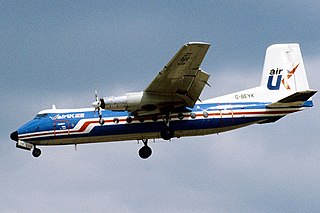
The Handley Page HPR.7 Dart Herald is a British turboprop passenger aircraft, designed in the 1950s as a DC-3 replacement, but only entering service in the 1960s by which time it faced stiff competition from Fokker and Avro. Sales were disappointing, contributing in part to the demise of Handley Page in 1970.

The FFVS J 22 was a Swedish single-engine fighter aircraft developed for the Swedish Air Force during World War II.

The VL Humu (Whirlwind) is a Finnish fighter aircraft, designed by Valtion lentokonetehdas in 1944, and based on the American Brewster F2A Buffalo.

The VL Myrsky ("Storm") is a Finnish World War II fighter aircraft originally developed by Valtion lentokonetehdas for the Finnish Air Force. The models of the aircraft were Myrsky I, Myrsky II, and Myrsky III.

The VL Pyörremyrsky ("Hurricane") was a Finnish fighter, designed by DI Torsti Verkkola at the State Aircraft Factory for service with the Finnish Air Force in World War II. The war ended before the type's first flight and only a prototype was built.
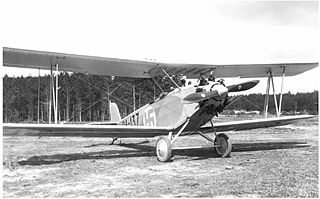
VL Paarma was a Finnish biplane, two-seat trainer aircraft, designed by the State Aircraft Factory for use with the Finnish Air Force.
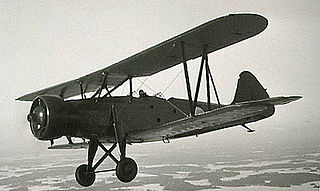
The VL Tuisku was a Finnish trainer aircraft designed in the 1930s. It was a two-seat, single-engined biplane with a welded steel framework, covered with fabric. 30 were produced for the Finnish Air Force and served from 1935 to 1949.

VL Viima, constructed by the State Aircraft Factory is a Finnish two-seat, biplane trainer used by the Finnish Air Force from the late 1930s to the early 1960s. After military service, several were released into civil use.

VL Pyry was a Finnish low-winged, two-seated fighter trainer aircraft, built by the State Aircraft Factory for use with the Finnish Air Force. The Pyry was in use from 1939 to 1962. The aircraft was a mixed construction of wood, steel, fabric, and duraluminium.

VL Kotka ("Eagle") was a Finnish two-seat, biplane maritime patrol aircraft, designed and built by the Valtion lentokonetehdas or VL. It was meant as a cheaper replacement for the outdated IVL A.22 Hansas that were in service with the Finnish Air Force.

VL Sääski II was the first series-produced aircraft designed in Finland. The aircraft was built by the State Aircraft Factory and was a two-seat, biplane, single-engine trainer constructed out of wood.

Valmet Vihuri was a Finnish advanced two-seat fighter trainer aircraft, serving in the Finnish Air Force between 1953 and 1959. Only a few airframes have survived, including one at the Central Finland Aviation Museum in Finland.
The Valmet L-80 TP Turbo-Vinha was a prototype for a new Finnish turboprop basic trainer aircraft. The aircraft, which carried the registration OH-VBB, first flew on 12 February 1985. It was destroyed in a crash on 24 April 1985, during its 14th flight, killing the test pilot Paavo Janhunen. The aircraft was a further development of the Valmet L-70 Vinka and would eventually lead to the Valmet L-90 Redigo.

Valtion lentokonetehdas was a Finnish aircraft manufacturing company that was founded on 23 February 1928 from the IVL or I.V.L. factory, founded in 1921.
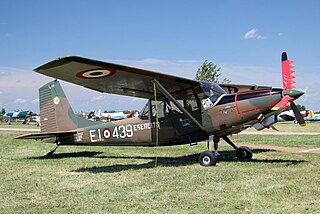
The SIAI-Marchetti SM.1019 is an Italian STOL liaison monoplane built by SIAI-Marchetti for the Italian Army. It is a turboprop-powered derivative of the Cessna O-1 Bird Dog.
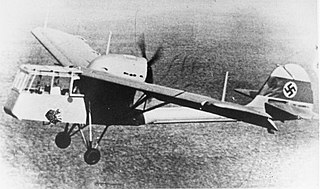
The Siebel Si 201 was a German air observation post and army cooperation aircraft, designed and built by Siebel. Evaluated against other types, the Si 201 did not enter production and only two prototypes were built.

The Slingsby Type 45 Swallow was designed as a club sailplane of reasonable performance and price. One of the most successful of Slingsby's gliders in sales terms, over 100 had been built when production was ended by a 1968 factory fire.



















